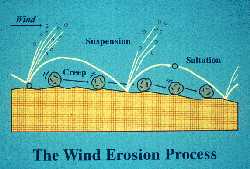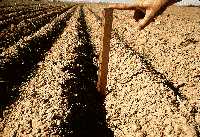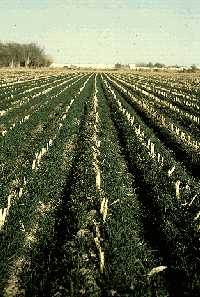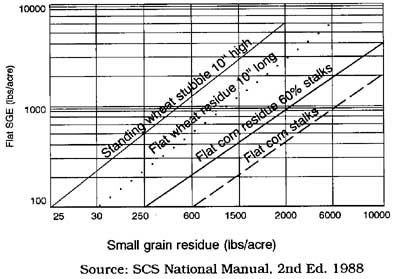by T.A. James, R.L. Croissant and G. Peterson1 (8/09)
Quick Facts…
- Vegetative barriers reduce erosion from wind by reducing unsheltered distance across fields.
- Barriers can protect young, sensitive, high-value crops from damage by blowing soil particles.
- Combinations of barriers and ridges can reduce residue requirements in conservation compliance plans.
- Fall-planted cover crops can prevent soil erosion by wind after harvest of low residue crops such as beans, beets, or potatoes. Covering the soil surface with crop residues is the most
effective means to control soil erosion.
Soil Erosion by Wind
Blowing soil can be an unpleasant nuisance, a serious safety hazard, or a costly disaster depending on one’s perspective and the intensity and duration of the windstorm. The public response to blowing soil has led to such legislation as the Colorado Dust Blowing Law and provisions of the 1985 Food Security Act.
 |
| Figure 1: The wind erosion process. |
Blowing soil or soil erosion by wind is a complex process. It involves detachment, transport, sorting, abrasion, avalanching, and deposition of soil particles. Turbulent winds above a threshold velocity (13 miles per hour at one foot above the ground) blowing over erodible soils can cause erosion or blowing. At selected locations and dates in Colorado, average wind speeds may exceed 5 to 9 miles per hour.
Wind transports soil particles in three ways:
Saltation. Individual particles are lifted off the soil surface by wind; then they return and the impact dislodges other particles. Fifty percent to 80 percent of total transport is by saltation.
Suspension. Dislodged particles, small enough to remain airborne for an extended period of time, are as visible as dust but generally make up less than 20 percent of the total soil transported.
Surface Creep. Sand-sized particles are set in motion by saltation. These sand size particles creep slowly along the surface. Up to 25 percent of total transport may be from surface creep. (Figure 1).
Barriers
Three primary means to control or reduce erosion or damage from wind are available.
- Decrease the distance across a field that receives no shelter from the wind.
- Form ridges with appropriate tillage equipment on the soil surface at right angles to the prevailing erosive winds.
- Protect the soil surface with a covering of plant residue or growing plants.
Unsheltered distance across a field is reduced by installing vegetative barriers at right angles to the prevailing erosive winds. These barriers reduce the soil transported by:
- providing a stable barrier to stop saltation of soil particles,
- trapping soil particles creeping along the ground, and
- reducing wind speeds below the threshold velocity along the ground for a distance of ten times (10x) the barrier height. This horizontal distance is sheltered from the wind, reducing the distance in a field where wind exceeds the threshold velocity. Table 1 illustrates the effect of installing barriers in a cropland field.
| Table 1: Conservation compliance systems providing equivalent soil loss1 in Lincoln County, Colorado. | |||
| Soil texture | Unsheltered distance(ft) | Surface residue (lbs/acre) | Number of vegetative barriers2 |
|---|---|---|---|
| Loamy fine sand | 2,640 | 500 | 0 |
| 330 | 350 | 8 | |
| Silt loam | 2,640 | 265 | 0 |
| 660 | 150 | 4 | |
| 1The predicted soil loss equals 14 tons annually per acre. 2The barriers consisted of seven rows of grain sorghum. Residues were present during the critical period, November through April. |
|||
 |
| Figure 2: Vegetative barrier of sorghum in field. |
Vegetative barriers (Figure 2) can consist of perennial plants or annual plants or a combination. Taller plants provide more protection than shorter plants when used at the same spacing. For example, a barrier of tall wheatgrass 2.5 feet high will provide a stable barrier as well as reducing the unsheltered distance by 25 feet (2.5 ft. x 10).
When annual plants such as corn, sorghum, or millet are used for barriers, the plants must be in place during the critical erosion period in order to be effective. In Colorado, the critical erosion period from wind is generally from November through April. Consequently, such annual barriers need to be planted in May or June and left undisturbed through the following April.
 |
| Figure 3: Ridging as an effective barrier. Here a deep furrow drill creates ideal ridges. |
Ridges
Ridging the soil surface can also be an effective practice. Ridges absorb and deflect wind energy and trap moving soil particles. Ridges with an ideal height to spacing ratio of 1:4 are most effective when constructed at right angles to the prevailing erosive wind. Ridges 4 inches high spaced 16 inches apart will provide optimum protection if oriented correctly.
Soil texture determines, to a great extent, the effectiveness and persistence of ridging. Silt loams, loams, and clay loams consolidate well with tillage and hold ridges against wind, rain, and snow impacts. Sandy loams, loamy sands, and coarse sands are easy to till into ridges but the ridges
deteriorate quickly.
Cover Crops
Cover crops work well in irrigated fields where moisture is not a limiting factor. Wheat or rye can be fall-planted after harvest of low residue crops, such as sugar beets, potatoes, or vegetables, if sufficient growing degree days remain to obtain germination and growth before winter freeze-up. Using close drill spacings of 6 to 7 inches and/or doubling the seeding rate will provide soil surface cover as rapidly as possible.
Early planting of winter wheat can offset insufficient surface residues if favorable growing conditions exist. However, unfavorable fall growing conditions can eliminate any advantage
to early plantings.
Crop Residues
 |
| Figure 4: Corn stubble is used as cover for winter wheat seeding. |
Using previous crop residues to protect the soil surface is the single most effective practice for controlling erosion from wind.
Crop residues vary in their effectiveness. Fine-strawed, upright stubble in rows perpendicular to the wind are more effective than large, randomly distributed stalks lying flat on the soil surface. Relationships have been developed to indicate the relative effectiveness of most types of crop residues. Figure 5 compares the effectiveness of corn and wheat residues.
Erosion control systems can be developed from a combination of practices to manage residues, ridge the soil surface, and reduce the unsheltered distance across fields.
The calculations to assess the effectiveness of any set of practices is laborious. However, there is software available at USDA SCS field offices in each Colorado county that will perform the evaluations.
The best way to estimate the amount of vegetative cover on a field is to use one of several methods:
Clip residue from 1 to 2 square yards on at least three different places, and weigh dry matter.
- Use a 100-foot tape, counting the number of intersects on each foot. Thirty-five intersects on the foot markers will indicate 35 percent residue cover. Additional calculations provide an estimate of residue weight.
- Various crop residue is compared to flat crop residue using flat small grain equivalents (wheat straw), with stubble 10 inches long, as the base.
 |
| Figure 5: Flat small grain equivalents for winter wheat and corn residues. |
Other residue configurations are visible when examining Figure 5. The standard “Flat winter Wheat” with 10-inch long stubble is compared with “Standing winter wheat” residue having stubble 10 inches long. From the graph, it is estimated that it takes 6,000 pounds of flat corn stalks to equal 1,000 pounds of flat small grain equivalent (SGE) per acre.
Agricultural producers planning for Conservation Compliance requirements are encouraged to contact the local SCS office for assistance.
1Originally written by T.A. James, agronomist, USDA Soil Conservation Service, Lakewood,
Colorado; and R.L. Croissant, Colorado State University Extension specialist, soil and crop sciences. 8/94. Reviewed by G. Peterson, department head, soil and crop sciences, Colorado State University. 8/09.
Go to top of this page.





